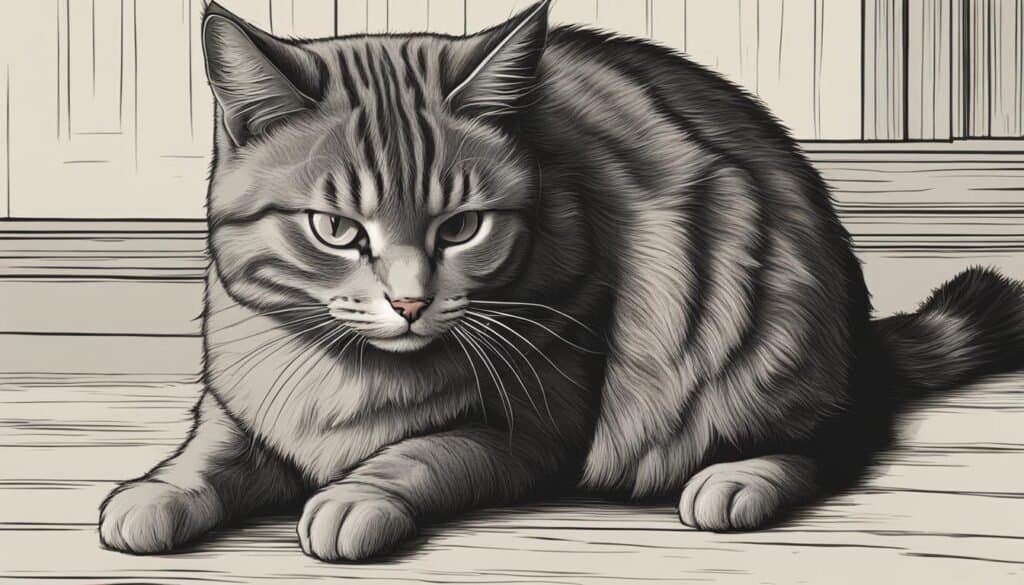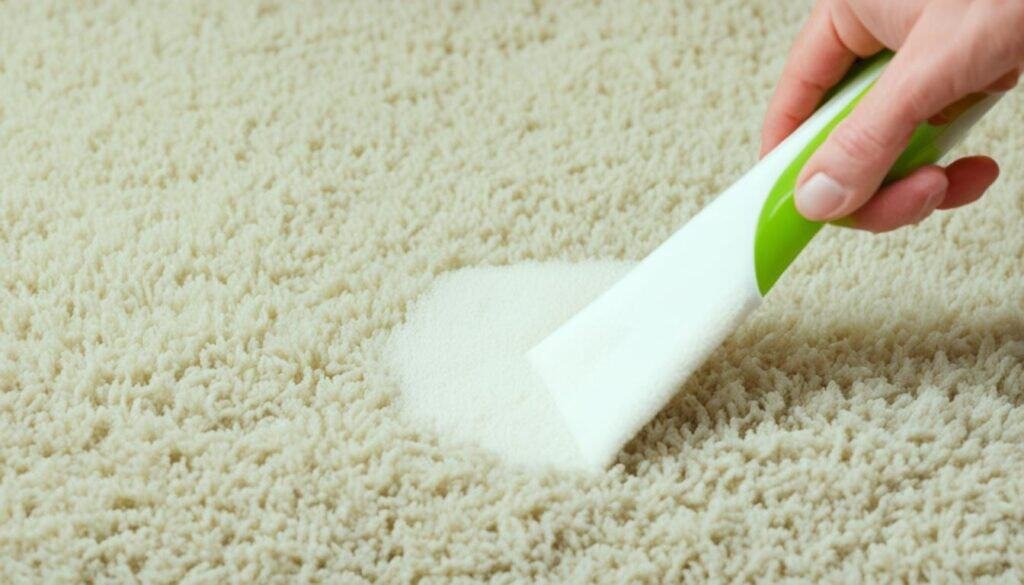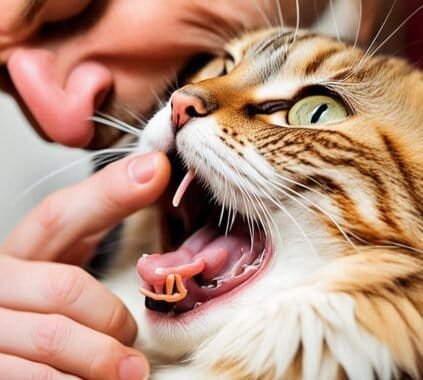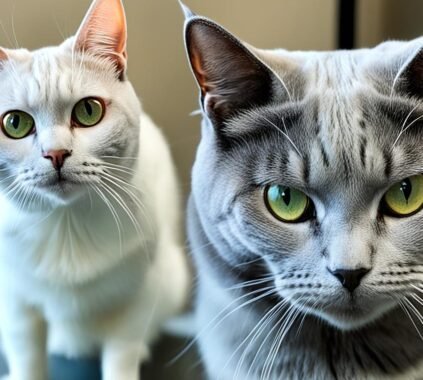Cat territory marking is a natural behavior in felines that involves the deposition of urine and other forms of scent communication. This behavior, also known as urine spraying, serves as a means for cats to establish ownership, communicate with other cats, and advertise their sexual availability within their territory.
Cats utilize various methods to mark their territory, including scratching, rubbing their face along surfaces, depositing stool, and, most notably, spraying urine. The act of urine marking involves the cat backing up to a surface, quivering its tail, and releasing a small amount of urine onto the marked area. This behavior is a crucial part of a cat’s scent communication system, where they use pheromones to convey messages to other members of their species.
Understanding why cats engage in territory marking is vital for proper management and addressing any underlying issues. This behavior can also occur in indoor cats, triggered by factors such as the presence of outdoor cats, changes in household routine, or the introduction of new objects or pets.
Key Takeaways:
- Cat territory marking involves the deposition of urine and other forms of scent communication.
- Marking behavior serves to establish ownership, communicate with other cats, and advertise sexual availability.
- Cats use scratching, rubbing, and spraying urine as methods of marking their territory.
- Understanding the reasons behind cat territory marking is crucial for effective behavior management.
- Trigger factors such as the presence of outdoor cats or household changes can lead to marking behavior.
What is Urine Marking or Spraying?
Urine marking is the deposition of urine for the purpose of communication. Spraying, a common form of urine marking, involves the cat backing up to a surface, quivering its tail, and spraying urine onto the surface. This behavior is part of a cat’s scent communication system, where they use pheromones to communicate with other members of their species.
Cats have scent glands in their feet, cheeks, chin, head, and tail base, which leave pheromone deposits as they move around their territory. Cats also mark through scratching and rubbing, which release pheromones and serve as visual communication.
The purpose of urine marking is to establish ownership, advertise sexual receptivity, and leave messages in socially important locations within their territory.
Why Do Cats Mark with Urine?
Cats engage in urine marking as a deliberate way to communicate important messages within their territory. Their urine contains pheromones, chemical substances that convey personal information and engage in social communication.
Through urine marking, cats can establish ownership of their territory and communicate their sexual receptivity and availability. This behavior is particularly prevalent in free-roaming, unneutered male cats, who may mark multiple times per hour.
However, even indoor cats have the innate need to communicate and may mark surfaces using their cheeks, claws, and urine. While marking is considered normal to a certain extent, it can also indicate distress or anxiety.
Cats may feel compelled to mark their territory due to perceived threats, changes in household routine, or the introduction of new objects or pets. Understanding the underlying reasons for urine marking behavior is crucial in effectively managing and addressing any potential issues.
Which Cats are More Likely to Urine Mark?
Both male and female cats can engage in urine marking behavior, but it is most common in intact (non-neutered) male cats. When an intact male sprays urine, it has a strong, pungent odor. Neutering the cat can change the odor of the urine and may reduce the motivation for spraying, but a small percentage of neutered males and spayed females may continue to spray. Cats in multiple-cat households are more likely to exhibit spraying behaviors, but even cats housed alone may spray. Understanding the demographics of cats that are more likely to urine mark can help in identifying and addressing the behavior.
In multiple-cat households, tensions over resources and territory can lead to an increase in marking behavior. Male cats, especially intact males, have a higher tendency to protect their territory and advertise their sexual availability through urine marking. Female cats may also mark their territory, particularly when in heat or if there is competition for resources.
Studies have shown that intact (non-neutered) male cats are the most likely to engage in urine marking behavior. Neutering the cats can significantly reduce the occurrence of urine marking, as it lowers the production of certain hormones responsible for marking behavior.
“While neutering is effective in preventing marking behavior in the majority of cats, a small percentage of neutered males and spayed females may still exhibit this behavior,” says Dr. Sarah Thompson, a veterinarian specializing in feline behavior. “Cats may continue to spray due to underlying medical conditions, stress, or unresolved territorial conflicts.”
“Intact male cats have a higher tendency to urine mark in order to establish ownership and advertise their sexual receptivity. However, it’s important to note that spayed females and neutered males can also engage in urine marking behavior, especially in multi-cat households.”
Identifying the factors that contribute to a cat’s likelihood of urine marking can help cat guardians take proactive measures to prevent and manage this behavior. Neutering can be particularly helpful in reducing marking motivation in both males and females by eliminating or reducing the odor and perceived need to establish territory through spraying.
Cats in multiple-cat households have a higher likelihood of urine marking
Common Triggers for Urine Marking
Urine marking in cats can be triggered by various factors that create anxiety and discomfort for our feline friends. Understanding these triggers is essential in managing and addressing this behavior. Let’s explore some of the common triggers for urine marking:
- Anxiety: Cats may mark their territory in response to threats that cause anxiety, such as the sight of outdoor cats through a window.
- Household changes: Changes in household routine, the addition of new people or pets, or even remodeling projects can trigger anxiety in cats and lead to marking behavior.
- Outdoor cats: The presence of outdoor cats near your home can be a trigger for urine marking as your indoor cat may feel the need to protect its territory.
- Frustration: Frustration can also contribute to urine marking. For example, an empty food bowl or waiting for a door to open can lead to marking behavior.
- Physical discomfort: Cats experiencing physical discomfort, such as urinary tract infections or other medical conditions, may engage in urine marking to communicate their discomfort.
Identifying and addressing these triggers can help in managing urine marking in cats and creating a harmonious living environment for both you and your feline companion.
“Understanding the common triggers for urine marking is essential in managing this behavior and providing a stress-free environment for your cat.”

Treatment for Urine Marking
Treatment for urine marking in cats focuses on addressing the underlying causes and decreasing the cat’s motivation to spray. A comprehensive treatment plan includes behavior modification techniques, territory management, and environmental enrichment. Neutering, clean litter boxes, and, in some cases, medication may also be recommended.
Behavior Modification
Behavior modification techniques play a crucial role in treating urine marking. By identifying and addressing the underlying issues, such as anxiety or territorial disputes, it is possible to modify the cat’s behavior. This may involve implementing positive reinforcement training and redirecting the cat’s marking behavior to more appropriate outlets.
Territory Management
Effective territory management helps reduce marking behavior in cats. Strategies may include providing vertical spaces, such as cat trees and shelves, to increase the cat’s territory and promote a sense of security. Additionally, creating designated scratching areas with scratching posts can provide an alternative outlet for marking behavior.
Neutering
Neutering (spaying for females and castration for males) can significantly reduce the motivation for marking behavior in intact cats. This surgical procedure decreases the production of reproductive hormones, which are often associated with spraying. Neutering should be considered as part of the treatment plan for urine marking.
Environmental Enrichment
Providing a stimulating environment for cats is crucial in preventing stress-related marking. Environmental enrichment involves offering toys, puzzle feeders, and interactive play sessions to keep the cat mentally and physically engaged. Creating a cat-friendly and enriching environment can help reduce anxiety-related marking behavior.
Clean Litter Boxes
Ensuring clean and accessible litter boxes is essential in preventing stress-related marking. Each cat in the household should have its own litter box, plus one extra, placed in different areas of the house. Litter boxes should be kept clean and regularly scooped to avoid any discomfort or aversion to using them as elimination sites.
“Behavior modification, territory management, neutering, environmental enrichment, and clean litter boxes are key components of successful treatment for urine marking in cats. By addressing the underlying issues and providing a suitable environment, we can help cats overcome this behavior and improve their overall well-being.”
For severe cases or when other approaches have not been successful, medication may be recommended to manage anxiety or other underlying behavioral issues. It’s essential to consult with a veterinarian or veterinary behaviorist to develop an individualized treatment plan based on the specific needs of your cat.
Cleaning and Preventing Re-Marking
Cleaning urine marks thoroughly is crucial to prevent re-marking by cats. When dealing with urine-saturated areas, it’s important to use products that neutralize the odor, such as Urine Away™. However, cleaning alone may not completely eliminate marking behavior, as cats may immediately refresh the area with more urine to leave their scent message.
One effective strategy is to change the purpose of the marked areas. By redirecting the cat’s behavior, you can discourage re-marking. For example, placing a feeding dish or a scratching post in the previously marked area can help shift the cat’s focus.
Changing the purpose of marked areas can sometimes resolve the problem.
In addition to changing the purpose, encouraging facial marking through cheek rubbing can also promote more socially acceptable marking behavior. Cats naturally mark with their facial glands, which leaves behind pheromones that serve as a less disruptive form of communication.

Another helpful approach is to provide synthetic pheromone products, such as Feliway® Optimum. These products mimic the calming pheromones naturally produced by cats, helping to create a more stress-free environment.
Litter Box Modification
Creating modified litter boxes in prime marking locations can provide an alternative outlet for marking behavior. By strategically placing litter boxes in areas where marking commonly occurs, you can encourage the cat to use the designated spot for eliminating instead of marking.
- Choose a litter box with high sides to minimize the chances of urine splashing outside the box.
- Consider using litter box attractants, which can help draw the cat’s attention to the appropriate elimination area.
- Regularly clean the litter boxes to maintain a fresh and inviting environment.
By implementing these strategies, you can effectively clean and prevent re-marking, creating a more harmonious living environment for both cats and their human companions.
Understanding Cat Marking and House Soiling
It is important to differentiate between marking behavior and house soiling, as they have different causes and implications. Any persistent urination or defecation outside the litter box should be evaluated by a veterinarian to rule out medical conditions.
Marking behavior involves the depositing of small amounts of urine on vertical surfaces, while house soiling usually entails larger amounts of urine or feces on horizontal surfaces. Cats that engage in marking behavior typically do not attempt to cover their elimination, as they want to leave their scent message.
Behavioral illnesses can also lead to litter box avoidance or preference for alternative elimination areas. If there is no medical explanation for the behavior, consulting a veterinary behaviorist for a behavior assessment and treatment program is advisable.
In some cases, cats may exhibit house soiling behavior due to underlying medical conditions such as urinary tract infections, kidney disease, or other health issues. These conditions can cause discomfort or pain during elimination, leading to inappropriate litter box usage.
Understanding the distinction between marking behavior and house soiling is essential in assessing the underlying cause and implementing effective treatment strategies.
Additionally, litter box problems can arise due to factors like litter box cleanliness, accessibility, and adequacy. Cats are naturally clean animals and may avoid using a litter box if it is dirty or if the litter is not to their preference. Multiple cats in a household may also have conflicts over litter box access, resulting in one or more cats avoiding the litter box.
Behavior assessment by a veterinary behaviorist can help identify the root causes of house soiling and provide guidance on addressing the behavior. Environmental modifications, such as providing multiple litter boxes, using appropriate litter substrates, and ensuring their cleanliness, can help prevent house soiling incidents.
Key Points:
- Marking behavior involves the depositing of small amounts of urine on vertical surfaces, while house soiling entails larger amounts of urine or feces on horizontal surfaces.
- Consulting a veterinarian is crucial to rule out any underlying medical conditions that may contribute to house soiling.
- Behavior assessment by a veterinary behaviorist can help identify the causes of house soiling and devise an appropriate treatment plan.
- Environmental modifications, including providing clean and accessible litter boxes, can help prevent house soiling incidents.
Conclusion
Cat territory marking, including the deposition of urine and other forms of scent communication, is a natural behavior in felines. Understanding the reasons behind this behavior is crucial for effective behavior management. By addressing the underlying causes and implementing appropriate treatment strategies, we can reduce urine marking in cats and create a harmonious living environment for both cats and their human companions.
To successfully manage cat territory marking, it is essential to identify triggers that may initiate marking behavior. Changes in household routine, the presence of outdoor cats, and other sources of anxiety can all contribute to marking behavior. By minimizing these triggers, we can help reduce the incidence of urine marking.
In addition to environmental modifications like providing vertical spaces, scratching posts, and synthetic pheromone products, behavior modification techniques may be necessary. Neutering cats can also be beneficial in reducing marking motivation, especially for intact male cats.
In some cases, medical interventions may be required. It is important to rule out any underlying medical conditions that may contribute to marking behavior. Consulting with a veterinarian or veterinary behaviorist can help determine the best course of action and develop a personalized treatment plan for each cat.
FAQ
What is cat territory marking?
How do cats mark their territory?
Why do cats engage in territory marking behavior?
Which cats are more likely to urine mark?
What are the common triggers for urine marking?
How is urine marking treated?
How can I prevent re-marking after cleaning soiled areas?
What is the difference between marking behavior and house soiling?
What should I do if my cat exhibits marking behavior?
Last modified: February 20, 2024














[…] Use a clicker or verbal cues to mark desired behaviors. […]
[…] Understanding cat behavior patterns is essential before implementing training strategies. […]
[…] we dive into specific positive reinforcement techniques, it’s essential to understand basic cat behavior and how they learn. This section will provide insights into the natural behaviors of cats and how […]